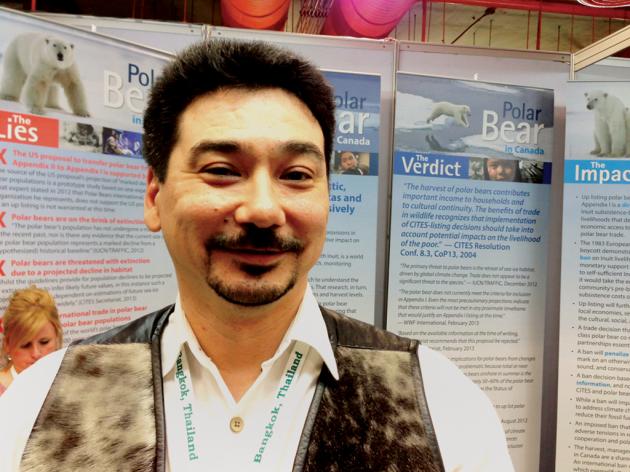Polar bear hunters promise restraint

Inuit hunters are celebrating their victory after the proposal by the US to ban cross-border trade in polar bears and their parts was defeated last week at an international wildlife and plant meeting but the hunters have promised to save the polar bear po
“We respect the polar bear. We don’t want to see it disappear. So we manage it very well,” Terry Audla, president of Inuit Tapiriit Kanatami (ITK), said at the 16th meeting of the Conference of the Parties (CoP 16) to the Convention on International Trade in Endangered Species of Wild Fauna and Flora (CITES).
ITK is the national Inuit organisation in Canada’s Nunavut territory representing four Inuit regions – Nunatsiavut (Labrador), Nunavik (northern Quebec), Nunavut, and the Inuvialuit Settlement Region in the Northwest Territories.
About 55,000 Inuit people live in the Canadian Arctic region, which has about two-thirds of the world’s polar bear population – about 16,000 to 18,000 polar bears. There are approximately 20,000-25,000 polar bears worldwide in Canada, Greenland [Denmark], Norway, Russia, and the US.
According to the report by the wildlife trade-monitoring network Traffic, polar bears historically were hunted using traditional methods at sustainable levels. However, there were concerns about the large numbers of polar bears sport-hunted and harvested commercially from the 1700s to the mid-1900s.
As a result of the signing of the 1973 Agreement on the Conservation of Polar bears and subsequent conservation efforts and actions taken by the range states including Canada, Greenland [Denmark], Norway, Russia, and the US, polar bears have not been commercially harvested since 1973. Only Canada permits the hunting of polar bears as a sport. Russia and Norway have not hunted polar bear since 1956 and 1957 respectively. Meanwhile, Canada, the US and Greenland are the only range states that currently allow hunting of polar bears for subsistence purposes.
“Inuit people rely on polar bear for food and money,” Audla said. “We do eat polar bear meat. It is like pork and lamb.” Inuit people do not hunt polar bear for commercial trade but they do benefit from it. For them, hunting is not a hobby or a luxury but it is a source of sustenance for the millennia.
To date, polar bears are listed and protected by the CITES’s Appendix II, which allowed legal hunting and international trade but with certain limitations.
Moreover, the polar bear population is managed by the Nunavut’s wildlife management system.
Under this system, there is a polar bear population quota, or total allowable harvest that limits the number of bears that can be harvested each year. The total number of bears hunted in populations managed by Nunavut was approximately 460 from July 1, 2011 to June 30, 2012. In Canada, the average annual harvest is about 500.
In 2011-2012, 41 bears were killed for hunting sport and about 419 were killed for subsistence hunting and self defence. “We have a quota to hunt about 700 polar bears a year but actually we annually hunt about 600 and 50 per cent of them go to trade,” a 42-year-old hunter said.
They also export polar bear parts like fur to China, Germany, France and Russia. Previously, they exported to the US as well but have now stopped.
To hunt polar bears, Inuit people will make a decision together about the number of polar bears that they would be able to hunt per year to ensure that they do not hunt too many.
“We are going to make sure that we don’t hunt too much so that the future of the polar bear population is healthy,” Audla said.
For Inuit people, however, hunting polar bears is not just about subsistence but also a local tradition. It shows that a 12 year-old Inuit boy has grown man enough to show responsibility to take care of a family and the community.
The US failed to get support from the majority at the world wildlife and plant summit in Bangkok for its proposal to move the polar bear from Appendix II to Appendix I. That would have meant a total ban on hunting and international commercial trade. The US revealed to the summit that the polar bear habitat will decline by 66 per cent in 2050, pointing to climate change and not trade as the main threat to the species.
Appendix I listing “is not the solution, but is part of the solution” for the protection of the species, the US representatives told the meeting.
RELATED
